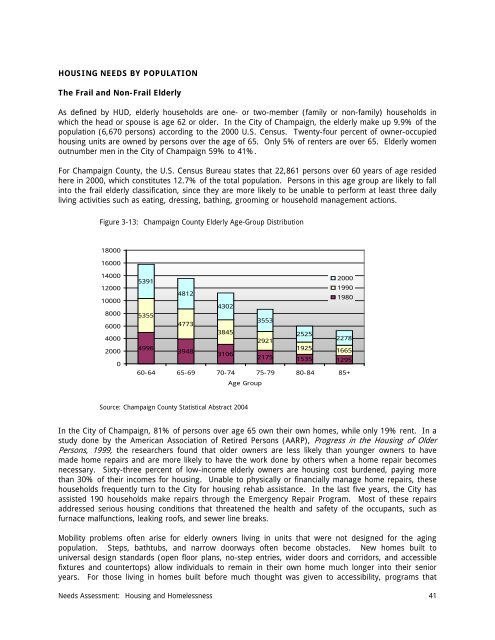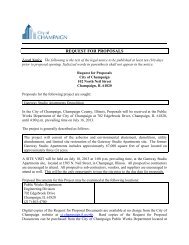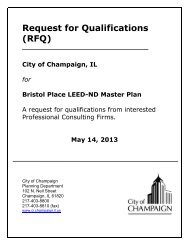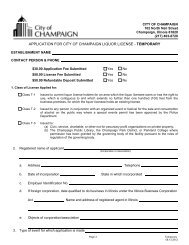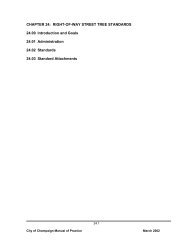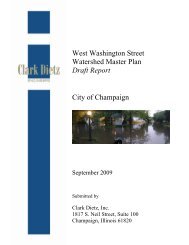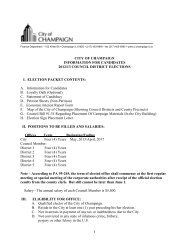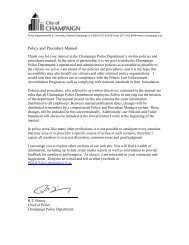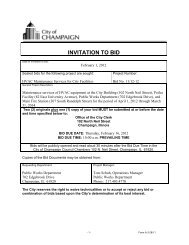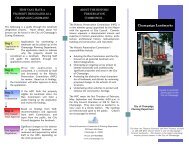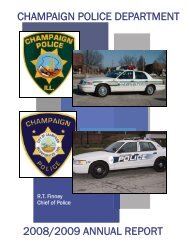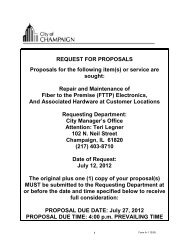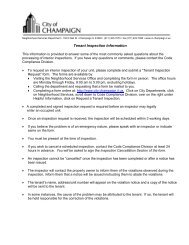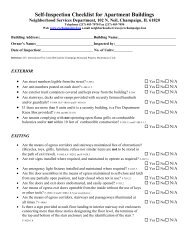2010-2014 Consolidated Plan - City of Champaign
2010-2014 Consolidated Plan - City of Champaign
2010-2014 Consolidated Plan - City of Champaign
Create successful ePaper yourself
Turn your PDF publications into a flip-book with our unique Google optimized e-Paper software.
HOUSING NEEDS BY POPULATIONThe Frail and Non-Frail ElderlyAs defined by HUD, elderly households are one- or two-member (family or non-family) households inwhich the head or spouse is age 62 or older. In the <strong>City</strong> <strong>of</strong> <strong>Champaign</strong>, the elderly make up 9.9% <strong>of</strong> thepopulation (6,670 persons) according to the 2000 U.S. Census. Twenty-four percent <strong>of</strong> owner-occupiedhousing units are owned by persons over the age <strong>of</strong> 65. Only 5% <strong>of</strong> renters are over 65. Elderly womenoutnumber men in the <strong>City</strong> <strong>of</strong> <strong>Champaign</strong> 59% to 41%.For <strong>Champaign</strong> County, the U.S. Census Bureau states that 22,861 persons over 60 years <strong>of</strong> age residedhere in 2000, which constitutes 12.7% <strong>of</strong> the total population. Persons in this age group are likely to fallinto the frail elderly classification, since they are more likely to be unable to perform at least three dailyliving activities such as eating, dressing, bathing, grooming or household management actions.Figure 3-13: <strong>Champaign</strong> County Elderly Age-Group Distribution1800016000140001200010000800060004000200002000539119904812198043025355355347733845252529212278499619253948166531062175 1535 129560-64 65-69 70-74 75-79 80-84 85+Age GroupSource: <strong>Champaign</strong> County Statistical Abstract 2004In the <strong>City</strong> <strong>of</strong> <strong>Champaign</strong>, 81% <strong>of</strong> persons over age 65 own their own homes, while only 19% rent. In astudy done by the American Association <strong>of</strong> Retired Persons (AARP), Progress in the Housing <strong>of</strong> OlderPersons, 1999, the researchers found that older owners are less likely than younger owners to havemade home repairs and are more likely to have the work done by others when a home repair becomesnecessary. Sixty-three percent <strong>of</strong> low-income elderly owners are housing cost burdened, paying morethan 30% <strong>of</strong> their incomes for housing. Unable to physically or financially manage home repairs, thesehouseholds frequently turn to the <strong>City</strong> for housing rehab assistance. In the last five years, the <strong>City</strong> hasassisted 190 households make repairs through the Emergency Repair Program. Most <strong>of</strong> these repairsaddressed serious housing conditions that threatened the health and safety <strong>of</strong> the occupants, such asfurnace malfunctions, leaking ro<strong>of</strong>s, and sewer line breaks.Mobility problems <strong>of</strong>ten arise for elderly owners living in units that were not designed for the agingpopulation. Steps, bathtubs, and narrow doorways <strong>of</strong>ten become obstacles. New homes built touniversal design standards (open floor plans, no-step entries, wider doors and corridors, and accessiblefixtures and countertops) allow individuals to remain in their own home much longer into their senioryears. For those living in homes built before much thought was given to accessibility, programs thatNeeds Assessment: Housing and Homelessness 41


